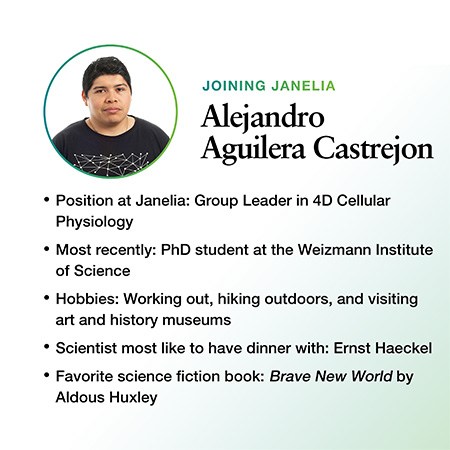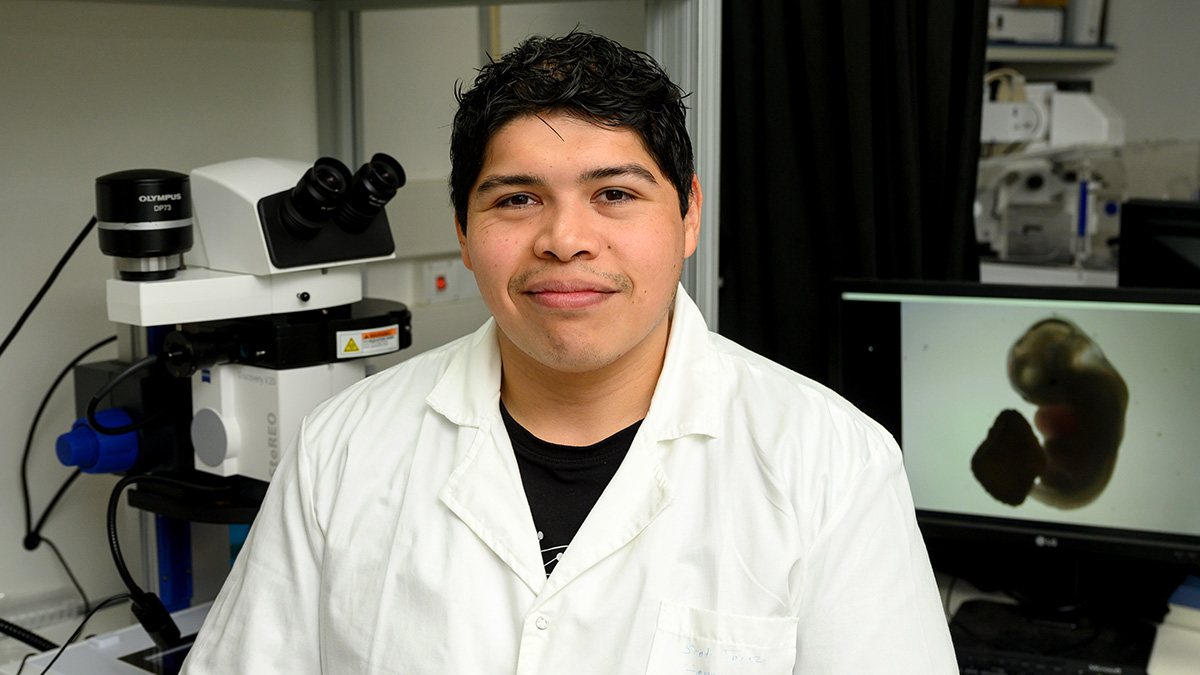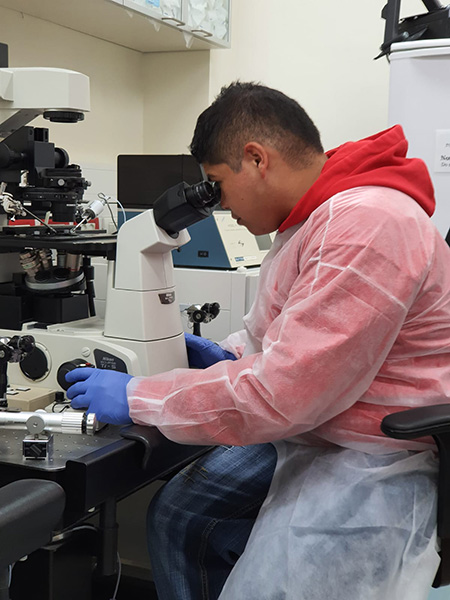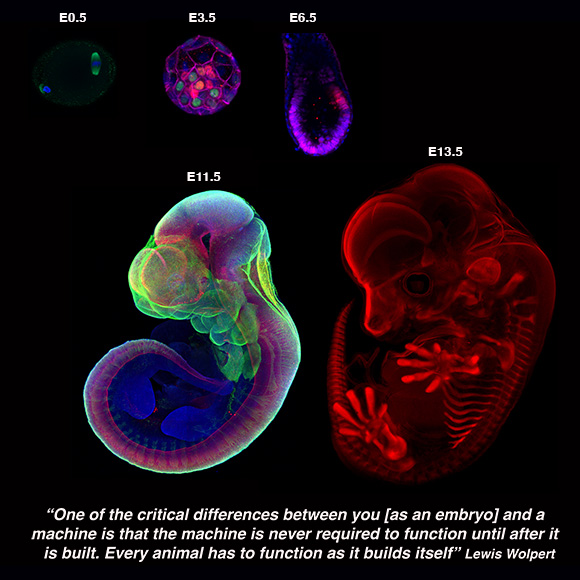Growing up in a suburb of Mexico City, Alejandro Aguilera Castrejon knew he wanted to follow a different path than his siblings, who struggled to put food on the table. He didn’t know if he could make a living from being a scientist, but his love of animals led him to study biology as an undergraduate. While getting his bachelor’s degree, Aguilera Castrejon discovered developmental biology and stem cell research and knew he had found his path, one that led him from Mexico to Israel and now to Ashburn, VA, where he is a new group leader in Janelia’s 4D Cellular Physiology research area.

HHMI Janelia: To start, tell us a little bit about your research.
Alejandro Aguilera Castrejon: We are trying to reconstitute mouse development outside the uterus. Mammals, like humans and mice, grow inside the uterus of their mothers, so this makes it very hard for us, as developmental biologists, to study how the embryo grows. Thus, we engineer systems that allow scientists to grow mammalian embryos without the need of the maternal uterus, so that you can easily do experiments on them and see how development happens in real time.
We use such systems to investigate how the organs form in the very early embryo. In the beginning, the embryo is just a sphere of cells that must go through a process called gastrulation to begin organ formation. During that process, the embryo passes from a sphere of cells into an animal with a defined body shape, and all the progenitors of the organs are set in their positions. This is the period we are most interested in, and we study it from several perspectives: genetics, mechanics, metabolism. We also use stem cells to “assemble” embryos.
HJ: How does this system work?
AAC: We all need food and oxygen to breathe – they are the most central elements of animal life. The embryos themselves need the same things. Because embryos are bigger than cells, scientists didn’t really have a way to properly deliver oxygen and nutrients to the embryos, and that is what our systems are doing.
We created a machine that regulates gas flow and pressure, as well as oxygen levels at different days of development – one of the main factors allowing the embryos to grow further. We also developed a specific medium, created with a high percentage of serum, that is very rich in nutrients. If you take blood and separate all the cells, what is leftover is the serum. It contains the nutrients and growth factors, proteins, and lipids that keep us alive. This serum also keeps the mouse embryos alive without the maternal nutrient supply.
We mix this serum with other components that are used to grow stem cells, and after many years of trial and error, we found the conditions that, for now, work best for us to maintain the growing mouse embryos.
HJ: What do you hope to find by doing this research?
AAC: I want to create a platform that will change the whole developmental biology and stem cell community, allowing them to investigate their own scientific questions. These platforms we’re creating to grow the mouse embryos for the longest time possible outside the uterus are just starting to be used by other scientists to study very specific organs. In the end, I would be happy if this platform were to be used generally by the whole community for their own research. Besides, I also expect to find new layers of regulation of development in mammals that were previously not known because it was not possible to grow embryos amenable to direct experimentation for such a long window of time.

HJ: What do you find interesting about this work?
AAC: I started out working with adult stem cells during my college bachelor’s in Mexico, and once I learned about embryo development, I was really fascinated by it – by how the embryo grows and how the cells know the position and the time when they form different organs. Then, I moved to Israel to work in a lab that was focusing on pluripotent stem cells. My mentor there also had a project about mouse embryos, and when I started working on it, I really liked it. So I decided that I wanted this to be my line of research.
I would like to understand how organs and life are formed. In the beginning we are only cells, but these cells go on to create a being. For me that’s amazing. This is a very difficult question to solve, and the fact that it’s hard makes me more interested in solving it. On the other hand, there’s also the technological aspect of my research. I would like to create something that people think is impossible. I like the challenge of creating something that doesn’t yet exist in the world.
HJ: What brought you to Janelia?
AAC: Actually, I didn’t know anything about Janelia. Janelia is not well known in the stem cell community. Then I saw the application for group leaders for this new research area, 4DCP, on Twitter. What attracted me to Janelia is that they bring together tool developers with biologists. I have always worked together with engineers and physicists, so it was important for me to find an institution that also has this interdisciplinarity, because that’s a fundamental part of my research. And the aims of 4DCP were similar to my research topic, to understand how tissues form and create organs and organisms, so I thought I should apply.
When I came to Janelia for the first time, I discovered all the ideas behind the institute. It’s a different way of doing science – that, by itself, is an experiment. Janelia’s ideology, it’s very similar to my own ideas. I would like to contribute to that, and to change the way science is done. So, it was not only the scientific part, but also the ideas behind the creation of the institute, and how differently science works here compared to other institutions, that attracted me.
 HJ: What do you like about working at Janelia?
HJ: What do you like about working at Janelia?
AAC: The fact that the PIs are expected to do experiments – that is something that was also attractive about coming to Janelia. I think that when a scientist doesn’t do experiments, they know the concepts, but they don’t know what is or is not possible to do. Sometimes only when you do something do you understand what can be changed and what cannot. So, this idea that the group leaders are expected to do experiments, and that basically Janelia removes all the administrative work from PIs, allowing them to focus on doing experiments, is fantastic.
I really like it here. People are always excited about collaboration, and they are happy to give you great new ideas. I think people at Janelia like to question small specific details that maybe in other places people don’t even see. I will say they have a different perspective.
HJ: Were you always interested in science growing up?
AAC: Not really. When people ask me this question, I say that I don’t know – I think I’m here by chance, somehow. I think at the beginning I just liked animals, so actually the reason why I studied biology is because I wanted to be in the jungle studying animals. But then I realized that’s not really for me, and in addition, in Mexico it’s very hard to find a job in that field.
I always thought about leaving Mexico. Where I grew up, there were very little resources. It was also dangerous, and you couldn’t really go out at night safely. I also saw the lives of the people in my family. They were always struggling – they didn’t have enough money to pay for the house, or even just to eat. So, I didn’t want to live like that, and I wanted to be able to help them.
In Mexico, many people have to work a lot. So people in my family, they work every day, even on holidays or weekends, because you have to do that if you want to survive. For me, working every day was normal, and I think that mentality helped me a lot in science. I consider that in science, you have to be smart, but most importantly, you need to put in a lot of effort to be successful.
HJ: What do you like to do outside the lab?
AAC: I really like working out and being outdoors. Here at Janelia, it’s amazing to walk to see the river, the lake, to hike. I’m a biologist so I really enjoy being outdoors, to look at the plants, fungi, and animals. I also like to watch sci-fi movies and read about science in general.
I go to the gym as well. I think it’s important because in the end, if you don’t take care of your health, it will affect your whole life, and you will not be able to do the things you love.
I also love art and history. I really love that nearby, in DC, you have a lot of museums on those topics.
HJ: Is there a famous scientist who you’d like to meet?
AAC: My favorite scientist is Ernst Haeckel. He created the concept of gastrulation, which is the process that I study. He also coined the term “stem cell,” which comes from the word stammzelle in German. He was one of the first few people who studied embryonic development, and he was also an artist – he did hundreds of very beautiful drawings on embryology and zoology.

Aguilera Castrejon Lab / We are interested in reconstituting mammalian development by devising ex utero culture systems for natural embryos and stem-cell derived embryo models. We aim to harness these platforms to understand how cells build embryos and how embryos build tissues and organs.
